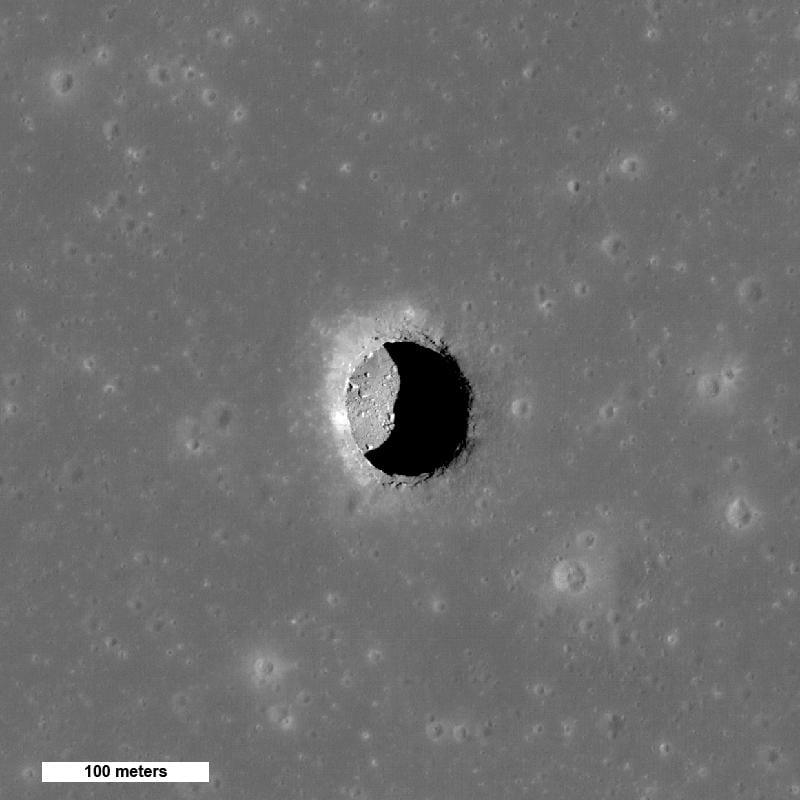How can artificial intelligence (AI) be used to locate lunar pits and skylights, which are surface depressions and openings, respectively, that serve as entrances to lava caves and lava tubes? This is what a recent study published in Icarus hopes to address as an international team of researchers investigated using machine learning algorithms to more efficiently identify pits and skylights on lunar volcanic regions (lunar maria) of the Moon. This study has the potential to help researchers develop new methods in identifying key surface features on planetary bodies that could aid in both robotic and human exploration.
For the study, the researchers used several deep learning models to identify pits and skylights using orbital images from the Moon and Mars with the goal of identifying new lunar pits and skylights to complement the 16 that have been previously identified with the Lunar Pit Atlas. One of the pits used to train the model was the well-known Mare Tranquillitatis Pit that has been imaged several times and estimated to have a minimum radius of 100 meters (328 feet) and a depth of approximately 105 meters (344 feet). In the end, the researchers found a deep learning model called ESSA (Entrances to Sub-Surface Areas) performed the best, as it successfully identified two new skylights despite only observing approximately 1.92 percent of the lunar maria.
The study notes, “Since ESSA has surveyed just ≈0.23% of the Moon’s surface so far, there are still vast amounts of data to which it can be applied. In the context of searching for pits and skylights which relate to potential cave entrances, mare regions should still be prioritized for being fed to ESSA. Up to now, ESSA has largely been applied to smaller mare deposits, which have well-defined boundaries, such as those within impact craters. However, with sufficient time allocated for the processing of imagery, ESSA could search for pits and skylights within some of the larger Lunar maria (such as Mare Frigoris) by iterating through latitude–longitude intervals.”
As noted, lunar pits and skylights serve as entrances to subsurface lava caves and tubes that could enable future robotic and human exploration to better understand the Moon’s volcanic history while also serving as shelter for future astronauts. This is because, unlike Earth, the Moon lacks an atmosphere with a protective ozone layer and magnetic field, thus exposing astronauts to harmful solar and cosmic radiation. Lava tubes played a prominent role in the television series National Geographic Mars as a safe haven for the first astronauts on Mars. Like the Moon, Mars lacks an ozone layer and magnetic field, so the lava tubes served as protective shielding from the harsh aforementioned solar and cosmic radiation.
This study comes as NASA’s Artemis program plans to send humans back to the lunar surface in the next few years for the first time since Apollo 17 in 1972. While Artemis plans to lands astronauts on the lunar south pole, far from lunar lava caves and tubes, this study demonstrates how AI and machine learning could be used to help identify key lunar surface features, potentially including water ice deposits and lunar resources that can be used for in situ resource utilization, the former existing within deep craters at the lunar south pole.
Additionally, the use of AI and machine learning models for planetary science continue to exhibit extraordinary speed and efficiency with the goal of enhancing our knowledge of planetary bodies, for planetary bodies of all sizes and types and both in and out of our solar system.
How will AI help identify pits, skylights, and other key surface features on the Moon and other planetary bodies in the coming years and decades? Only time will tell, and this is why we science!
As always, keep doing science & keep looking up!
